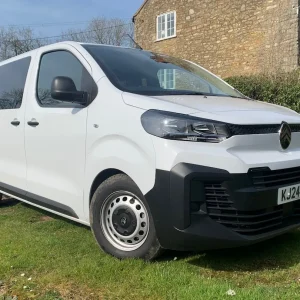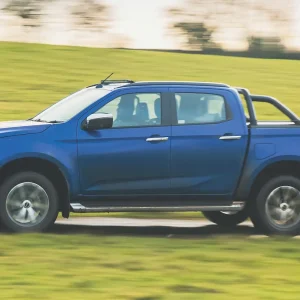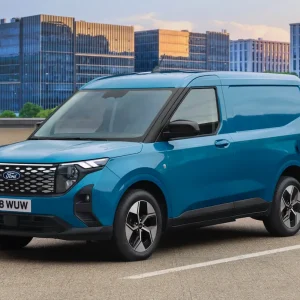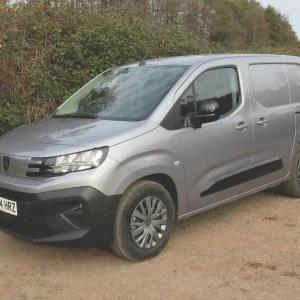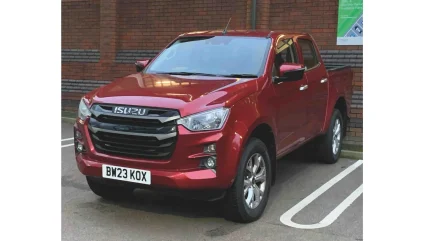
Final Report
Following its stint on the What Van? fleet I have now parted company with the Isuzu D-Max DL20 having had an opportunity to assess its strengths and weaknesses over a six-month period.
Overall it was a mixed bag, with the DL20 demonstrating it is more suited to some applications than others rather than proving its worth as an all-rounder. In contrast to the top-of-the-range V-Cross, Isuzu does not pitch the DL20 as a lifestyle model; it is unashamedly a workhorse truck in the brand’s largely rural-based tradition. As such it can feel like a fish out of water in urban environments.
While I was confident the DL20 would not sustain damage when bowling over speed bumps or stumbling into potholes it felt less at home weaving about the capital’s tight, busy streets or negotiating the narrow, spiralling lanes in underground and multi-storey car parks. The need to work the notchy six-speed manual gearbox hard during urban assignments can be tiring and I would advise operators not spending most of their time cruising on open roads to opt for the six-speed automatic transmission.
The DL20 does not get a reversing camera like higher-grade models in the line-up and its rudimental parking sensor does not inspire confidence during tricky reversing manoeuvres.
Isuzu employs a 1.9-litre, 164hp diesel engine throughout the entire D-Max range and while it was an upgrade on the 2.5 unit it replaced in 2017, it now falls short compared to rivals’ engines in terms of both power and refinement. With a load on board it feels laborious until building up a head of steam and noise levels can be intrusive. Having said that a towing capacity of 3.5t and a payload comfortably above 1.0t are competitive.
With the countdown underway for the withdrawal of ICE-powered vehicles and with Isuzu having announced its intention to produce an electric pick-up truck, customers are likely to have to put up with the 1.9-litre engine until 2035. That’s not necessarily bad news; the engine delivers competent performance off-road and with 4L (4WD low) mode and a diff lock available, operators are not likely to get in trouble when venturing off the beaten track.
A downside for the DL20 is the infotainment and switchgear installed in the cabin. The interface is out of date and fiddly to use and the Bluetooth phone connectivity is both difficult to set up and, frankly, dangerous to engage while driving. The DAB connection frequently cuts out and the radio controls are far too small. Isuzu should consider rectifying this by fitting the 7in or 9in touchscreens that feature in higher trim levels to the DL20.
Where the D-Max range fares far better is in the generous provision of safety equipment, raising the bar in the sector by gaining a Five Star rating from Euro NCAP.
As standard all models get forward collision warning, autonomous emergency braking, traffic sign recognition, which combines with an intelligent speed limiter to alter speeds between zones, and lane departure warning with a lane departure prevention system that adjusts the steering if the driver starts to cross lanes without indicating.
Overall, the D-Max DL20 is a capable, reliable truck but is starting to look long in the tooth and lacks the sophistication of competitors’ equivalent mid-range models.
End of term report
Working credentials = 4/5
The DL20 offers few frills but is a dependable workhorse.
Cabin = 3/5
A comfortable enough space but could do with an upgrade.
Fuel economy = 3/5
Improved once not restricted to inner-city assignments.
Driving = 4/5
The DL20’s handling and ride quality are decent for a big truck.
Off road = 4/5
At home off the beaten track and can cope with extreme conditions.
Refinement = 2/5
Falls short compared to rivals as well as higher-specced D-Max models.
Overall score = 67%
Isuzu DL20 Double Cab 4×4
Mileage 2,966mls
Official combined fuel economy 33.6mpg
Our average consumption 33.3mpg
Price range (ex VAT) £23,929-£35,779
Price (ex VAT) £29,679
Warranty 5yrs/125,000mls
Service intervals 12,000mls
Load length 1,495mm
Load width (min/max) 1,110/1,530mm
Gross payload 1,120kg
Braked towing weight 3.5-tonnes
Engine size/power 1,898cc/164hp
Gearbox 6-spd manual
CO2 220g/km
Options (prices ex VAT)
Tow bar £275.00
13 pin towing electrics £185.50
Over rail liner £247.50
5th Report
The 1.9-litre 164hp diesel engine that powers the entire D-Max line-up, from humble Utility single cab up to the latest swaggering limited edition Steel, which is based on the top of the range V-Cross, has received criticism for lacking grunt and performance credentials compared to the drivetrains installed in some of its competitors.
Aside from the outrageous 3.0-litre 289hp V6 petrol engine that propels Ford’s Ranger Raptor, the mainstream Ranger line-up gets a 3.0-litre 240hp diesel and a 2.0-litre diesel producing 205hp and 170hp. Based on the same platform as the Ranger, Volkswagen’s Amarok gets the same engines apart from the V6 petrol. The Toyota Hilux was also previously called out for being underpowered but has supplemented its 2.4-litre 150hp unit with a much meatier 2.8-litre 204hp diesel. The KGM (formerly Ssangyong) Musso meanwhile, gets a 2.2-litre 199hp diesel engine.
As well as being more modest in horsepower terms than rivals, the D-Max’s engine also suffers in terms of refinement, it is far noisier than the Ranger’s 2.0-litre lump, for example. On the plus side, once it has built up a head of steam, the DL20 does not feel underpowered even with a substantial load on board.
When Isuzu introduced the 1.9-litre engine in 2017, it had the novelty of being the only pick-up engine not to require Ad Blue, but as emissions standards have become more stringent it does now need topping up with the Urea-based solution to remove nitrogen oxide emissions (NOx) to keep it on the right side of the law.
In recent weeks I have spent more time driving the DL20 on longer trips beyond the city limits and as a result the truck’s fuel economy has improved substantially and is now close to the official combined-cycle figure of 33.6mpg. During the excessively wet weather that engulfed the nation, particularly the part of the west country
I visited in early spring, I was grateful for the DL20’s ability to remain unruffled under all conditions. Riding on 18in alloy wheels, the truck can cope with most on-road surfaces in 2WD but slipping it into 4H (4WD high) with a simple twist of the dial by the gear stick, means you can tackle slippery terrain like muddy tracks or waterlogged fields without trepidation.
I have not had to resort to 4L (4WD low) mode that provides drive to all four wheels in a low gear ratio for extra grip in extreme off-road environments and nor have I needed to engage the diff lock, which the ‘DL’ in the truck’s name stands for. It provides extra traction at up to 19mph by keeping the left and right wheels on the rear axle turning at the same speed. Most customers, such as farmers, for example, will rarely, if ever, need to call upon these functions but it is reassuring to know they are available, just in case. The same can be said for the joint class-leading wading depth of 800mm. If a less off-road-capable vehicle gets stuck then the tow bar affixed to my DL20 as a £275,000 (ex-VAT) option should come in handy to pull it back onto the right track. What’s more, as a vehicle designed to venture into harsher environments than most, it’s good to know the DL20 is equipped with a full-size spare wheel.
Report card: Off road = 4/5
The DL20 is at home off the beaten track and equipped to cope with
extreme conditions.
Isuzu DL20 Double Cab 4×4
Mileage 2,696mls
Official combined fuel economy 33.6mpg
Our average consumption 33.2mpg
Price range (ex VAT) £23,929-£35,779
Price (ex VAT) £29,679
Warranty 5yrs/125,000mls
Service intervals 12,000mls
Load length 1,495mm
Load width (min/max) 1,110/1,530mm
Gross payload 1,120kg
Braked towing weight 3.5-tonnes
Engine size/power 1,898cc/164hp
Gearbox 6-spd manual
CO2 220g/km
Options (prices ex VAT)
Tow bar £275.00
13 pin towing electrics £185.50
Over rail liner £247.50
4th Report
The Isuzu D-Max is a sleekly handsome pick-up truck that cuts an imposing presence on the kerbside as well as on the road.
It is more modestly proportioned than some of its chunkier rivals, which seem to value bulk as a virtue, but is none the worse for that and, to my mind, looks particularly appealing clad in the ‘Spinel Red Mica’ (AKA maroon) paintwork that adorns my DL20.
Last year’s redesign of the front grille and the addition of new wheels have enhanced the D-Max’s aesthetic appeal too.
Another advantage of the D-Max’s comparatively diminutive dimensions is that it has an unladen weight of less than 2,040kg, which means it is subject to car rather than commercial vehicle speed limits, giving it the edge over all its rivals bar the now withdrawn Mitsubishi L200. Goods vehicle speed limits are 10mph lower than car limits on single and dual carriageways. As a consequence, the D-Max can achieve better journey times than competitors while remaining on the right side of the law.
The replacement of the old hydraulic set up with electromechanical steering has improved handling, it is light and easy to manage at slow speeds but stiffens up nicely when you pick up pace. The long overdue installation of a rake and reach adjustable steering wheel also helped.
Isuzu puts a marked improvement in ride quality compared to the first generation D-Max down to reworked leaf-spring suspension and a new chassis cab mount that absorbs more noise, vibration and harshness and enhances comfort in the cab. The engine can still sound gruff and grumbling when moseying about town but this becomes far less apparent once the truck is out on the open road.
As I suspected, breaking out of the confines of the capital’s streets, where a somewhat hit and miss stop and start system doesn’t help much, also leads to a marked improvement in fuel economy – boosting consumption from well under 27mpg to comfortably over 29mpg on a return trip from London to Birmingham, for example.
The DL20’s gear changes still waiver towards the notchy side but the (relatively) new, shorter gear stick is a vast improvement on its long and spindly predecessor.
Overall though, customers may be well advised to consider the six-speed automatic transmission rather than the six-speed manual driven here.
Notchy gear changes are not an issue, of course, when bowling along the motorway but it’s as well to be aware of what may trigger any one of the D-Max’s many driver assistance systems to kick in. Neglect to indicate when changing lanes, for instance, and the lane departure warning and prevention system will forcefully pull the truck back into line. This focus on keeping the cab’s occupants safe from harm is admirable but some devices, such as the forward collision warning, can be over zealous, with a tendency to flash red and bleep hysterically when no obstacle is in the vehicle’s path.
Overall, however, the DL20’s interior is a pleasant place to be on long journeys, the front seats are comfortable and I’ve had no complaints from those in the rear either.
Report card: Driving = 4/5
The Dl20’s handling and ride quality are both impressive for a big truck.
Isuzu DL20 Double Cab 4×4
Mileage 1,924mls
Official combined fuel economy 33.6mpg
Our average consumption 29.6mpg
Price range (ex VAT) £23,929-£35,779
Price (ex VAT) £29,679
Warranty 5yrs/125,000mls
Service intervals 12,000mls
Load length 1,495mm
Load width (min/max) 1,110/1,530mm
Gross payload 1,120kg
Braked towing weight 3.5-tonnes
Engine size/power 1,898cc/164hp
Gearbox 6-spd manual
CO2 220g/km
Options (prices ex VAT)
Tow bar £275.00
13 pin towing electrics £185.50
Over rail liner £247.50
3rd Report
The UK’s thriving pick-up sector is based upon the popularity of double-cab lifestyle models, which, being classed as commercial vehicles, benefit from a favourable tax regime that allows VAT to be reclaimed and ensures exemption from passenger car levels of benefit-in-kind (BIK) taxes, which scale upwards according to CO2 emissions, with a much lower standard flat rate paid instead.
In February, however, HMRC sent shockwaves through the sector by announcing that from 1 July even double-cab trucks with a 1.0t payload would cease to be classed as commercial vehicles and would be subjected to passenger car levels of BIK, which would have seen tax payments increase fourfold, largely due to the relatively high emissions of diesel pick-up trucks.
Although Isuzu built its reputation as a maker of robust, hardworking pick-ups and markets single and extended-cab models, which would have retained their commercial vehicle status under the new tax laws, it has also relied heavily on more luxurious, and bigger-selling, double-cab lifestyle models like the Blade, XTR and V-Cross.
A week after the taxation decision was announced, however, the sector was granted a reprieve when the government made a U-turn on the proposed changes, having, it said, listened to the concerns of the motor industry and farmers.
It may or may not have been a coincidence that on the day the government announced the U-turn Prime Minister Rishi Sunak was making a speech to the National Union of Farmers.
As a single-model brand the proposed change to the laws could potentially have dealt a huge blow to Isuzu’s business in the UK. Last year the D-Max was the UK’s third best-selling pick-up (6,315) behind the Ford Ranger and Toyota Hilux.
The 1.9-litre 164hp diesel engine that serves the entire D-Max line-up is comparatively low powered for a pick-up truck. Isuzu started using the engine in 2017 when it replaced the old 2.5-litre 163hp unit.
The differences in economy and emissions compared with bigger-engined competitors, however, are perhaps not as marked as might be expected. The manual D-Max Utility single-cab in both 4×2 and 4×4 modes, along with all the manual 4×4 double-cab models, have official CO2 emissions of 220g/km and fuel economy of 33.6mpg.
The 2.0-litre 170hp Ford Ranger 4×4 Ecoblue XL regular cab has figures of 226g/km CO2 and 32.8mpg, as does the XL double cab.
D-Max double-cab autos, though, emit 241g/km CO2 on the combined WLTP cycle and manage 30.7mpg. By comparison, the 2.0-litre 205hp Ranger Wildtrak auto has figures of 227g/km CO2 and 32.5mpg.
Turning to Toyota, the 2.4-litre 150hp Active single cab emits 249g/km CO2 with fuel economy of 28.5mpg but the Hilux Invincible X double cab manual with the newer 2.8-litre 204hp engine has official CO2 emissions of 225g/km and economy of 31.3mpg.
The claimed CO2 emissions and fuel economy figures for my D-Max DL20 on the combined cycle are 220g/km and 33.5mpg. With the majority of its time spent covering urban routes though, the fuel economy figure is currently falling well short. This should improve once the truck gets a few more extra-urban trips under its belt.
Report card: Fuel economy = 3/5
Fair to middling in the city but should improve on extra-urban assignments.
Isuzu DL20 Double Cab 4×4
Mileage 1,582mls
Official combined fuel economy 33.6mpg
Our average consumption 27.7mpg
Price range (ex VAT) £23,929-£35,779
Price (ex VAT) £29,679
Warranty 5yrs/125,000mls
Service intervals 12,000mls
Load length 1,495mm
Load width (min/max) 1,110/1,530mm
Gross payload 1,120kg
Braked towing weight 3.5-tonnes
Engine size/power 1,898cc/164hp
Gearbox 6-spd manual
CO2 220g/km
Options (prices ex VAT)
Tow bar £275.00
13 pin towing electrics £185.50
Over rail liner £247.50
2nd Report
Unless employed in the building trade, by a landscape gardener or spending much of its time putting in shifts on construction sites, the D-Max is less at home in the city than in the countryside where the trucks can often be seen rubbing shoulders with the tractor and trailer in farmyards across the nation’s rural counties.
This is particularly true of the more workhorse-oriented models in the D-Max line-up, such as my DL20 double-cab.
Isuzu has traditionally marketed its pick-up trucks in rural communities, at country fairs, for example, and most of its dealerships are located outside of big cities.
During the last couple of months though, I must confess my DL20 has spent most of its time out of its natural habitat, serving as an urban runaround. Its open-topped load bed has been used to carry the weekly ‘big shop’ and boxes of books for charity, securely fastened down with bungee straps attached to the load bed’s eight tie-down points (two either side and two at each end) rather than bails of straw or bundles of firewood.
The big truck copes better when bowling over speed bumps, keeping within 20mph speed limits, of course, than it does when forced to negotiate the narrow, winding lanes in underground and multi-storey urban car parks where I’ve occasionally needed to stop and reverse before taking a second run at particularly tight entrances and exits. I should stress, however, that the two-metre height limits are not a problem.
So, what’s the cabin like as a place to wile away the hours when stuck in cross-town traffic? Well, for a start, it takes a bit of effort to get into. Unlike higher-spec D-Max derivatives, such as the DL40 and V-Cross, the DL20 does not come with a footstep to ease your entry into the cabin, although the driver and front passenger do get a grab handle, at least.
The driver’s seat is manually six-way adjustable, and the steering wheel is height and reach adjustable, which makes it easy to find the most comfortable driving position, as does a driver’s footrest and central armrest.
Despite the DL20’s relatively lowly position in the D-Max hierarchy, it’s nice to find the cab is not entirely Spartan and includes features such as heated front seats, which were particularly welcome in the January cold snap, and steering wheel-mounted controls for audio and cruise control. The fact that the latter is not adaptable though, means I have steered clear of using it on rare forays beyond city limits.
Storage provision is good and includes front cup holders, door bins that can accommodate litre water bottles, a decent-sized lidded central storage box, a glove box and a shelf on the dashboard top. The DL20’s seats are cloth-covered (leather comes from DL40) and in my opinion are none the worse for that.
On the downside, the DL20 does not get the 7in and 9in touchscreens that feature in higher-spec models and the radio is small and fiddly to operate. It does come with DAB but this has a tendency to lose reception and cut out. Although Bluetooth is purportedly part of the package I have found this to be impossible to engage (see picture) and so have not been able to pair my smartphone to enable hands-free calls. A blast from the past is the inclusion of a CD player, not to mention the old school ignition key and manual handbrake. While the D-Max range overall is generously equipped with ADAS, the rear parking sensor on the DL20 is less impressive: the long gaps between bleeps when reverse is engaged suddenly become frenzied, making parking manoeuvres difficult to judge and more stressful then necessary. With the high bonnet making it difficult to gauge distances in front of the truck, a forward sensor would be a useful addition too.
Report card: Cabin = 3/5
A comfortable enough space but the switchgear could do with an upgrade.
Isuzu DL20 Double Cab 4×4
Mileage 1,521mls
Official combined fuel economy 33.6mpg
Our average consumption 27.7mpg
Price range (ex VAT) £23,929-£35,779
Price (ex VAT) £29,679
Warranty 5yrs/125,000mls
Service intervals 12,000mls
Load length 1,495mm
Load width (min/max) 1,110/1,530mm
Gross payload 1,120kg
Braked towing weight 3.5-tonnes
Engine size/power 1,898cc/164hp
Gearbox 6-spd manual
CO2 220g/km
Options (prices ex VAT)
Tow bar £275.00
13 pin towing electrics £185.50
Over rail liner £247.50
1st Report
Much like that of its predecessor the Rodeo, the Isuzu D-Max’s reputation was built upon its rugged workhorse credentials and off-road ability.
The introduction of more upmarket models, such as the Blade, XTR and V-Cross, showed Isuzu could hold its own in the UK’s popular lifestyle pick-up market but the brand never lost sight of the D-Max’s hard-working roots. The latest addition to What Van?’s long-term fleet, the D-Max DL20, continues this tradition. Isuzu places its pick-up trucks in three categories: Utility, All Purpose and Adventure.
Utility consists of a 4×2 single cab, a 4×4 single cab, an extended cab and a double cab (both 4×4). All of these get a six-speed manual gearbox.
All Purpose encompasses the DL20 extended cab with the manual gearbox and two double cabs, one manual, which is the version we have, and one with a new six-speed auto transmission, and the DL40, comprising manual and auto double cabs.
The ‘DL’ indicates a selectable differential lock, which Isuzu says delivers better traction off-road than a limited-slip differential. The diff lock is standard on all bar the Utility models.
The Adventure category houses the flagship V-Cross, which is also available with manual or automatic transmissions.
The DL20 is powered by the 164hp 1.9-litre engine, which serves the whole line-up having replaced the old 163hp 2.5 lump in a 2017 facelift. Despite some initial misgivings that it might lack the brute force of its predecessor, the new powertrain has largely won over the doubters by proving its muscle in challenging environments.
An area where the D-Max range excels is in the provision of advanced driver assist systems (ADAS), which has won it a 5 Star Euro NCAP safety rating. As standard the truck gets forward collision warning, autonomous emergency braking, traffic sign recognition, which combines with an intelligent speed limiter to alter speeds between zones, and lane departure warning, with a lane departure prevention system that adjusts the steering if the driver is about to cross lanes without indicating.
All derivatives feature a forward-facing stereo camera that can detect pedestrians, cyclists and other vehicles. The manufacturer claims that, unlike other cameras in the pick-up segment, Isuzu’s camera has two lenses and gauges distance by comparing the two readings – operating in a similar way to a human eye. It says the camera can identify vehicles from 120m away.
Double-cab trucks come with a rear radar that enables additional ADAS features such as a blind spot monitor that detects vehicles in the driver’s blind spot and alerts the driver via an orange warning light in the door mirror. The warning light will flash if the driver indicates to move into the lane where a vehicle is detected. If the driver fails to take action emergency lane keeping will adjust the steering to prevent the lane change. Isuzu claims this is the first time such equipment has been a standard fit on double-cab pick-ups in the UK. Double-cab trucks also get rear cross-traffic alert to detect vehicles approaching from the rear when reversing out of a parking space.
The D-Max has undoubtedly benefited from the withdrawal of some of its competitors from the pick-up sector, particularly the Mitsubishi L200 and Nissan Navara, which has left the all-conquering Ford Ranger, Toyota Hilux and more marginally, the Ssangyong Musso as its main rivals.
The DL20 double cab has a payload of 1,120kg and a towing capacity of 3.5-tonnes. This compares to 1,140kg and 3.5-tonnes for the Ford Ranger XL double cab, 1,105kg and 3.5-tonnes for the Toyota Hilux Active double cab and 1,105 and 3.2-tonnes for the Ssangyong Musso EX double cab.
Report card: Working credentials = 4/5
The DL20 offers few frills but is a dependable workhorse.
Isuzu DL20 Double Cab 4×4
Mileage 1,521mls
Official combined fuel economy 33.6mpg
Our average consumption 27.7mpg
Price range (ex VAT) £23,929-£35,779
Price (ex VAT) £29,679
Warranty 5yrs/125,000mls
Service intervals 12,000mls
Load length 1,495mm
Load width (min/max) 1,110/1,530mm
Gross payload 1,120kg
Braked towing weight 3.5-tonnes
Engine size/power 1,898cc/164hp
Gearbox 6-spd manual
CO2 220g/km
Options (prices ex VAT)
Tow bar £275.00
13 pin towing electrics £185.50
Over rail liner £247.50

